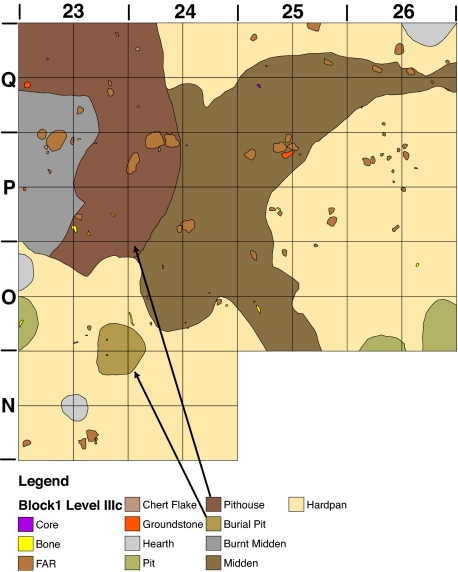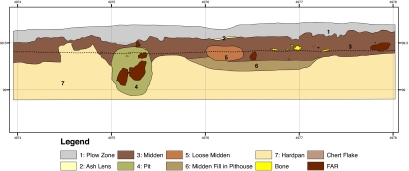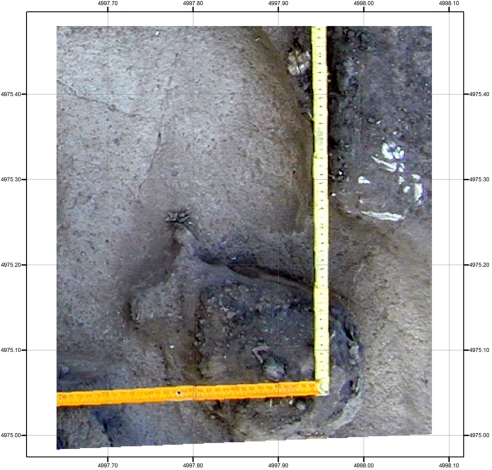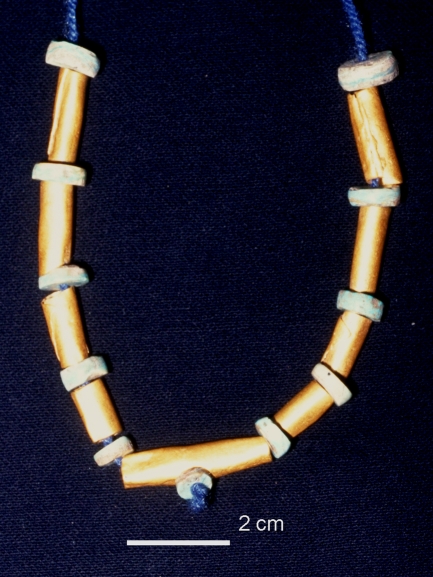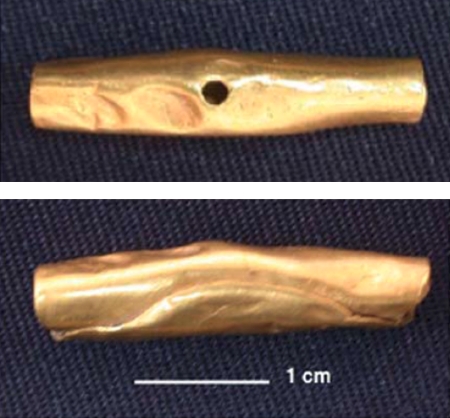Abstract
Artifacts of cold-hammered native gold have been discovered in a secure and undisturbed Terminal Archaic burial context at Jiskairumoko, a multicomponent Late Archaic–Early Formative period site in the southwestern Lake Titicaca basin, Peru. The burial dates to 3776 to 3690 carbon-14 years before the present (2155 to 1936 calendar years B.C.), making this the earliest worked gold recovered to date not only from the Andes, but from the Americas as well. This discovery lends support to the hypothesis that the earliest metalworking in the Andes was experimentation with native gold. The presence of gold in a society of low-level food producers undergoing social and economic transformations coincident with the onset of sedentary life is an indicator of possible early social inequality and aggrandizing behavior and further shows that hereditary elites and a societal capacity to create significant agricultural surpluses are not requisite for the emergence of metalworking traditions.
Keywords: archaeology, Archaic, metallurgy, Andes
Gold artifacts have often been discovered in copious quantities at the archaeological sites of cultures characterized by the presence of hereditary elites and complex economies with extensive trade networks. In these societies, gold was generally used to signal high status and was frequently incorporated into the dress and costumes of elite individuals. Based on this association, the tradition of gold working has often been associated exclusively with a high degree of social and political complexity, wherein elites supported craft specialists and provided them with access to necessary raw materials (1). This view assumes that, because gold metalworking can be technically complex and demanding, such traditions are feasible only when sufficient wealth, often in the form of agricultural surpluses, has been accumulated by these elites such that it can be used in the production of luxury objects (2).
The discovery of a gold necklace associated with a burial at Jiskairumoko, a small site occupied by a hunting and gathering people in the Lake Titicaca basin of southeastern Peru, however, calls these assumptions into question and suggests that status displays using gold artifacts in this region began long before the appearance of more complex societies capable of generating surpluses. The find also supports the hypothesis of an early advent of gold working in relatively simple societies.
The transition to sedentary life by hunters and gatherers can be associated with significant social and economic transformations. These include displays of valued objects that have been seen as the material manifestation of aggrandizing behaviors as individuals, families, or other social factions compete for status and new leadership positions (3–5) or may also signal differences in lineage, age, gender, or ethnicity. Objects composed of exotic, nonlocal, or difficult-to-obtain and difficult-to-process materials are frequently used in status display and competition. As such, they reflect the skill, ability, wealth, and range of social contacts of those individuals who possess them, thus enhancing their prestige. Their value in these competitive displays is further enhanced and imparted into social memory if they are disposed of in mortuary contexts or destroyed. Such status competitions are considered by anthropologists to be one pathway toward the establishment of persistent, multigenerational leadership in the transition to settled, sedentary life (6–8).
Gold artifacts were used as status markers among ancient Andean cultures. Many later, more complex societies, including Chavín, Moche, Chimú, and Inca, made great use of gold (9–11). The earliest published sites with gold artifacts or evidence of gold-working technology are Mina Perdida in the Lurín Valley [1410 to 1090 calendar years (cal yr) B.C.] (12) and Waywaka in the central Andean highlands in Andahuaylas (≈1500 to 1000 cal yr B.C.) (13, 14). The 14C assay for Waywaka reported here is 3440 ± 100 14C yrs B.P. (UCLA-1808A) and has been recalibrated by us using Calib 5.0.2html with the Southern Hemisphere atmospheric calibration curve (15). Although the stratigraphic context of the gold at Waywaka appears to be secure, it has been dated only by association with a ceramic assemblage that has a wide chronological range. The gold may thus date significantly later in time, and recently the dating of the ceramic assemblage has been revised downward and may be no earlier than 1000 cal yr B.C. (16). We have chosen to be conservative in our assessment of the age of the gold.
Both sites were inhabited by settled village agriculturalists capable of generating surplus, and in the case of Mina Perdida the inhabitants constructed impressive corporate civic-ceremonial architecture. Until the discovery of gold at Jiskairumoko, none had been found in the sites of transhumant low-level food-producing peoples.
Research at Jiskairumoko
Excavations at Jiskairumoko, located in the Río Ilave drainage of southern Peru, have revealed a transition to sedentary life beginning in the Late Archaic around 3400 cal yr B.C. and culminating by 2000 cal yr B.C. in the Terminal Archaic (17). Multiple lines of evidence attest to this transition. Geomorphological data from the Ilave river drainage (18) and limnological data from Lake Titicaca (19, 20) show that a key river terrace—Terrace 2—was created by ≈2300 cal yr B.C. as the level of the lake rose from a much lower level in the mid-Holocene. Over the next 2,000 years increased precipitation led to terrace aggradation, creating a favorable environment for an increase in the density and abundance of plant species of dietary importance in the region, most notably Chenopodium spp. (17, **). Settlement data from the Ilave basin reflect population growth, settlement aggregation, and the movement of large sites toward the Terrace 2 margins during the Terminal Archaic (17, 18).
By 2300 cal yr B.C., a small hamlet was present at Jiskairumoko. Geophysical survey and extensive excavation revealed the presence of five pithouses arranged in a circular pattern. Storage alcoves within each of these structures had total capacities ranging from 130 to 150 liters. The primary components of the diet consisted of Chenopodium spp., tubers (Solanum and Ullucus/Oxalis spp. identified through starch grains extracted from grinding tools), and animal protein [taruca (Hippocamelus antisensis) and camelids] (17, 21, **). The presence of storage features and the plant species themselves indicate long-term residence at the site at least through the spring and well into the dry season. This interpretation is bolstered by evidence of extensive remodeling and repair of the pithouse structures, patterned secondary refuse disposal, periodic cleaning, and the structured, regular use of space (22). These patterns are commonly observed in the ethnographic record of the long-term residential sites of transhumant low-level food-producing peoples (23).
The site has multiple occupations extending from the Late Archaic into the Early Formative period as revealed by projectile point styles, ceramics, and 14C assays, which date the span of its use from ≈3600 to 1500 cal yrs B.C. [supporting information (SI) Table S1]. Late Archaic point styles include the diagnostic 4D and 4F series; these are followed by the Terminal Archaic 5C type (24). The earliest ceramic materials at the site are consistent in surface treatment, paste, and vessel shape with published descriptions of the Pasiri tradition, which is currently the best-defined early ceramic assemblage in the Lake Titicaca basin and which dates from ≈1500 to 1000 cal yrs B.C. (25).
At the time of excavation, the site had been plowed by draft animal traction for many decades. This created a plow zone of mixed soil that varies in depth from 10 to 25 cm and that averages at 15 cm (Fig. S1). The extreme northern boundary of the site was disk-plowed in 2000. However, this portion of the site is >25 m to the north of the location of the pit that contained the human burial and gold artifacts, and it was plowed the year after the excavation of the burial that contained the gold (Fig. S2).
The burial that contained the gold was recovered from a small pit, circular in plan view with straight walls, that was dug into the Level IIIc surface located ≈1 m south of a contemporary Terminal Archaic pithouse structure (Fig. 1). In this area of the site, Level IIIb is below the disturbed soils of the plow zone, and the context shows no signs typical of churning by agricultural activity (Fig. 2 and Fig. S3). The burial pit originates on Level IIIc. A careful examination of the Level IIIb soil matrix that lies above the burial pit shows no evidence of the excavation of a pit into the soil matrix of Level IIIc from above (see Figs. S4 and S5). No features dating to the Formative period intrude into Level IIIc in this area of the site. The burial pit, then, is in primary archaeological context, originates in Level IIIc, and shows no signs of modification or disturbance after its initial excavation.
Fig. 1.
Line drawing of the Block 1, Level IIIc surface on which the burial pit containing the gold was encountered. The lowermost arrow points to the location of the burial pit. The Terminal Archaic pithouse is indicated with the uppermost arrow. Each grid square is 50 cm in length. North is at the top of the image.
Fig. 2.
Stratigraphic profile of the east wall of excavation Block 1 ≈1 m to the west of the pit location. The surface of Level IIIc (indicated by the dotted line) is clearly defined by stones and pit outlines. Note that the IIIc surface lies well below the plow zone.
The human remains in the burial pit consisted of mixed adult and juvenile cranial fragments and cervical vertebrae (K. Prizer, personal communication). The adult fragments could not be sexed, but tooth wear was very extensive, indicating that the individual was elderly. The juvenile was between 4 and 6 years of age based on fusion of the cervical neural arches. The adult cranium rested on its right side and faced the bottom of the burial pit. The bones were in extremely poor condition, highly eroded, and friable, making it impossible to use them to date the remains directly. The pit context at the time of discovery was damp, and the bone was in danger of being destroyed. A decision was made at the time to remove the pit contents as an entirety and to examine the burial in a secure laboratory context to preserve as much of the bone as possible and to avoid the theft of the gold because looting at the site had been a problem. The pit itself and the resting spot of the burial are well defined and, as noted above, do not show evidence of disturbance (Fig. 3).
Fig. 3.
Base of the pit that contained the burial after the removal of the matrix containing the human remains and the gold. Note the generally oval or circular shape of the pit.
Nine gold beads were discovered near the base of the adult cranium close to the mandible. They were found in a roughly circular pattern within the soil matrix that surrounded the cranium, and 11 circular beads of a coarse greenstone (possibly sodalite) were found interspersed between them. The location of the beads in relationship to the cranium and the pattern of the beads themselves are strongly suggestive of a necklace that must have been placed around the neck of the adult (Fig. 4). A small fragment of burned wood recovered directly below the mandible at the contact interface with the surrounding soil matrix was submitted for 14C assay and was dated to 3733 ± 43 14C yrs B.P. (AA-36815) or 2155 to 1936 cal yrs B.C., calibrated by using Calib 5.0.2html with the Southern Hemisphere atmospheric calibration curve (15). This date is internally consistent with all other radiometric dates (n = 25) obtained from the site (17) and is archaeologically contemporaneous with the date of initial occupation of the nearby Terminal Archaic pithouse: 3838 ± 75 14C yrs B.P. (AA-36818) or 2473 to 2119 cal yrs B.C.
Fig. 4.
A reconstruction the gold and turquoise beads as a necklace. The central gold bead has a turquoise bead attached through a perforation in its center.
The beads are thick and cylindrical in shape. They are variable in length but are quite similar in diameter and to a lesser extent thickness. Weight varies accordingly (Table 1). One of the beads—Number 5, the longest and heaviest—has been perforated, and a small greenstone bead was found near the perforation in the soil matrix (Fig. 5Upper).
Table 1.
Dimensions and composition of beads
| Bead | Length, mm | Diameter, mm | Thickness, mm | Weight, g | Au, % | Ag, % | Cu, % |
|---|---|---|---|---|---|---|---|
| 1 | 20.5 | 7 | 1 | 4.2 | 95.4 | 4.3 | 0.27 |
| 2 | 18.5 | 6 | 1 | 3.3 | 95.9 | 3.8 | 0.31 |
| 3 | 14.0 | 6 | 0.5 | 1.5 | 95.1 | 4.6 | 0.29 |
| 4 | 12.0 | 6 | 0.7 | 2.0 | 95.1 | 4.6 | 0.29 |
| 5 | 29.0 | 7.5 | 0.5 | 5.2 | 95.5 | 4.2 | 0.30 |
| 6 | 11.5 | 7.0 | 1 | 1.8 | 96.1 | 3.6 | 0.29 |
| 7 | 15.0 | 6.5 | 0.5 | 1.7 | 95.3 | 4.5 | 0.21 |
| 8 | 19.0 | 7 | 0.6 | 3.8 | 95.6 | 4.1 | 0.27 |
| 9 | 21.0 | 6.6 | 0.9 | 4.3 | 95.1 | 4.6 | 0.32 |
| Average | 95.5 | 4.3 | 0.28 |
Fig. 5.
Details of bead 5 fabrication. (Upper) Bead 5 showing perforation; note the large hammer marks to the left of the perforation. (Lower) Bead 5 showing the folding of the hammered gold.
The elemental composition of the gold beads was characterized with a portable x-ray fluorescence (PXRF) spectrometer. They are chemically homogeneous, and the proportional values of gold, silver, and copper found in them are comparable to published samples of native gold from nearby regions of the Andes (Table 1). Extensive placer (or detrital) and quartz-vein gold is found to the north of Jiskairumoko on the eastern flanks of the Andes in the Río Sándia basin and the Department of Madre de Dios. Assays of the Sándia sources of native gold show elemental composition ranges of gold from 98.5% to 91.6% and ranges of silver from 1.85% to 5.6%. Cu values are not reported. Nuggets of native gold from the Sándia vein sources are often >1 cm in diameter (26, 27). We conclude that these beads were likely fabricated from quartz-vein native gold nuggets. Given the limitations of PXRF for sourcing gold, we cannot identify a specific source.
No obvious tools used to create the beads were found at the site, and, thus, the method of fabrication remains speculative. However, each of the beads shows distinctive hammer marks, suggesting that the raw native gold was first flattened with a stone hammer and then carefully bent and/or hammered around a hard cylindrical object to create the tubular shape. Despite the hammering, the metal maintained its ductility through this process. The edges of the beads are clearly folded over and do not appear to have been cut (Fig. 5 Lower). The beads do not appear to be laminated or composed of distinct layers of gold foil, and no evidence of annealing can be observed.
The discovery of the gold beads at Jiskairumoko supports a hypothesis that the earliest metalworking in the Andes was the modification of native gold (28). Although both native gold and copper were cold-hammered at Mina Perdida, the materials from Jiskairumoko are at least 600 years earlier than these finds. There are striking differences in the objects produced among the sites. At both Mina Perdida and Waywaka, small, very thin foils of gold and copper were produced, and at Mina Perdida, there is evidence of gilding and annealing copper foils (12). However, these more complex metalworking technologies appear relatively late in the second millennium B.C. (16) and were preceded by experimentation with native metals in a variety of forms.
The gold from Jiskairumoko in a Terminal Archaic context provides new insight into the emergence of Andean metalworking and supports the concept of the early appearance of multiple, independent metalworking technologies focused on native materials, especially gold. From very early times, gold functioned in ceremonial, ritual, and mortuary contexts (12, 13, 29). The data from Jiskairumoko also allow us to document an emerging social role for gold beyond simple decoration. Used in a necklace, the gold served to signal the prestige of its wearer, while its interment with the deceased underscored the implied wealth and prestige of its owner through its disposal and removal from both display and recirculation. Over the next three millennia, gold would continue to highlight and emphasize prestige, but its use was ultimately restricted to the elite members of society (29). The gold from Jiskairumoko provides new insight into one pathway by which this process occurred. Furthermore, these data suggest that the cold hammering of native gold nuggets may be one of the earliest technologies used to fashion objects for status display in those areas of the world in which social and political complexity emerged.
Methods
Analyses were conducted by using an Amptek PXRF. The x-ray tube features a 30-kV/100-μA power supply with an Ag target and Be end window. The detector is thermoelectrically cooled and has a resolution of 149 eV FWHM at the 5.9-kV peak of 55Fe. Because of the irregularity of sizes and shapes of archaeological materials, the tube and detector are mounted to a specially fabricated table so as to hold the components in a fixed geometry and at a consistent distance for each measurement. For each analysis, the flattest part of the sample was selected to minimize surface effects and scatter. The gold was analyzed at 20 kV and 5 μA in an air path for 200 seconds live-time. Thin film standards of single and multiple elements deposited on Nucleopore filters were used for the energy calibration of the instrument. Standards used in the analysis included RM-8079 (Royal Canadian Mint gold foil) and BCR-6091 (European Commission, Institute for Reference Materials and Measurements bronze standards). The XRF-FP software provided with the instrument calculates quantitative data for the elemental compositions of the samples using a fundamental parameters algorithm. Values for each analysis were constrained to 100%.
Acknowledgments.
We thank Rolando Paredes, former director of the Instituto Nacional de Cultura, Puno, for permission to examine the beads in 2005. David Killick of the University of Arizona provided comments about sourcing gold. We acknowledge the support of the National Science Foundation through Grant SBR-9816313 (to M.A. for the excavations at Jiskairumoko) and Grant BCS-0405042 (to Michael Glascock, R.J.S., J. David Robertson, and Christophe Descantes), the University of Missouri (Columbia, MO) for funding for the PXRF, and a National Science Foundation graduate fellowship (to R.P.-F.).
Footnotes
The authors declare no conflict of interest.
This article is a PNAS Direct Submission.
Aldenderfer M, et al. (2007) 47th Annual Meeting of the Institute of Andean Studies, January 12, 2007, Berkeley, CA.
This article contains supporting information online at www.pnas.org/cgi/content/full/0710937105/DCSupplemental.
References
- 1.White LA. The Evolution of Culture. New York: McGraw Hill; 1959. pp. 333–338. [Google Scholar]
- 2.Childe VG. New Light on the Most Ancient Near East. New York: Praeger; 1953. pp. 123–147. [Google Scholar]
- 3.Price DT, Brown JA. In: Prehistoric Hunter-Gatherers: The Emergence of Cultural Complexity. Price DT, Brown JA, editors. New York: Academic; 1985. pp. 3–20. [Google Scholar]
- 4.Clark JD, Blake M. In: Factional Competition and Political Development in the New World. Brumfiel EM, Fox J, editors. Cambridge, UK: Cambridge Univ Press; 1994. pp. 17–30. [Google Scholar]
- 5.Hayden B. In: Emergent Complexity: The Evolution of Intermediate Societies. Arnold J, editor. Ann Arbor, MI: Intl Monographs in Prehistory; 1996. pp. 50–58. [Google Scholar]
- 6.Aldenderfer MS. In: Foundations of Power in the Prehispanic Andes. Vaughn KJ, Ogburn DE, Conlee CA, editors. Vol 14. Arlington, VA: Am Anthropol Assoc; 2005. pp. 13–35. [Google Scholar]
- 7.Hayden B. In: Foundations of Social Inequality. Price DT, Feinman GM, editors. New York: Plenum; 1995. pp. 13–86. [Google Scholar]
- 8.Strathern A. Inequality in New Guinea Highlands Societies. Cambridge, UK: Cambridge Univ Press; 1982. [Google Scholar]
- 9.Burger RL, Lechtman H. In: Andean Art at Dumbarton Oaks. Boone E, editor. Washington, DC: Oaks; 1996. pp. 45–86. [Google Scholar]
- 10.Alva W. Oro en el Antiguo Perú. Lima, Perú: Banco de Crédito del Perú; 1992. [Google Scholar]
- 11.McEwan C. Precolumbian Gold: Technology, Style, and Iconography. London: British Museum Press; 2000. [Google Scholar]
- 12.Burger RL, Gordon RB. Early Central Andean metalworking from Mina Perdida, Peru. Science. 1998;282:1108–1111. doi: 10.1126/science.282.5391.1108. [DOI] [PubMed] [Google Scholar]
- 13.Grossman JW. An ancient gold worker's tool kit: The earliest metal technology in Peru. Archaeology. 1972;25:270–275. [Google Scholar]
- 14.Grossman JW. Demographic change and economic transformation in the south-central highlands of pre-Huari Peru. Ñawpa Pacha. 1983;21:45–126. [Google Scholar]
- 15.Reimer PJ, et al. IntCal04 terrestrial radiocarbon age calibration, 0–26 cal kyr BP. Radiocarbon. 2004;46:1029–1058. [Google Scholar]
- 16.Shimada I. In: Quest of Mineral Wealth: Aboriginal and Colonial Mining and Metallurgy in Spanish America. Craig AK, West R, editors. Baton Rouge, LA: Louisiana State Univ; 1994. pp. 55–66. [Google Scholar]
- 17.Craig N. Santa Barbara: Univ of California; 2005. The formation of early settled villages and the emergence of leadership: A test of three theoretical models in the Rio Ilave, Lake Titicaca basin, southern Peru. PhD dissertation. [Google Scholar]
- 18.Rigsby C, Baker PA, Aldenderfer MS. Fluvial history of the Rio Ilave Valley, Peru, and its relationship to climate and human history. Palaeogeogr Palaeoclimatol Palaeoecol. 2003;194:165–185. [Google Scholar]
- 19.Baker PA, et al. The history of South American tropical precipitation for the past 25,000 years. Science. 2001;291:640–643. doi: 10.1126/science.291.5504.640. [DOI] [PubMed] [Google Scholar]
- 20.Cross SL, Baker PA, Seltzer GO, Dunbar RB. A new estimate of Holocene lowstand level of Lake Titicaca, Central Andes, and implications for tropical palaeohydrology. Holocene. 2000;10:21–32. [Google Scholar]
- 21.Murray AP. Fullerton: California State Univ; 2005. Chenopodium domestication in the south-central Andes: Confirming the presence of domesticates at Jiskairumoko (late Archaic-Formative) Perú. MA thesis. [Google Scholar]
- 22.Craig N, Aldenderfer M, Moyes H. Multivariate visualization and analysis of photomapped artifact scatters. J Archaeol Sci. 2006;33:1617–1627. [Google Scholar]
- 23.Binford L. In Pursuit of the Past: Decoding the Archaeological Record. New York: Thames and Hudson; 1983. [Google Scholar]
- 24.Klink C, Aldenderfer M. In: Advances in Titicaca Basin Archaeology I. Stanish C, Cohen A, Aldenderfer M, editors. Los Angeles: Cotsen Instit of Archaeol, Univ of California; 2005. pp. 25–54. [Google Scholar]
- 25.Stanish C. Ancient Titicaca: The Evolution of Complex Society in Southern Peru and Northern Bolivia. Berkeley: Univ of California Press; 2003. pp. 102–104. [Google Scholar]
- 26.Peterson G. Minería y Metalurgia en el Antiguo Perú. Antropología e Historia del Perú Lima, Perú: Museo Nacional de Arqueología; 1970. [Google Scholar]
- 27.Haeberlin MR, Fontboté L. Paleozoic orogenic gold deposits in the Eastern Central Andes and its foreland, South America. Ore Geol Rev. 2003;22:41–59. [Google Scholar]
- 28.Lechtman H. In: The Coming of the Age of Iron. Wertime TA, Muhly JD, editors. New Haven, CT: Yale Univ Press; 1980. pp. 269–334. [Google Scholar]
- 29.Lechtman H. Andean value systems and the development of prehistoric metallurgy. Technol Culture. 1984;25:1–36. [Google Scholar]



